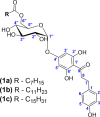Strategy for the Enzymatic Acylation of the Apple Flavonoid Phloretin Based on Prior α-Glucosylation
- PMID: 38350922
- PMCID: PMC10905995
- DOI: 10.1021/acs.jafc.3c09261
Strategy for the Enzymatic Acylation of the Apple Flavonoid Phloretin Based on Prior α-Glucosylation
Abstract
The acylation of flavonoids serves as a means to alter their physicochemical properties, enhance their stability, and improve their bioactivity. Compared with natural flavonoid glycosides, the acylation of nonglycosylated flavonoids presents greater challenges since they contain fewer reactive sites. In this work, we propose an efficient strategy to solve this problem based on a first α-glucosylation step catalyzed by a sucrose phosphorylase, followed by acylation using a lipase. The method was applied to phloretin, a bioactive dihydrochalcone mainly present in apples. Phloretin underwent initial glucosylation at the 4'-OH position, followed by subsequent (and quantitative) acylation with C8, C12, and C16 acyl chains employing an immobilized lipase from Thermomyces lanuginosus. Electrospray ionization-mass spectrometry (ESI-MS) and two-dimensional nuclear magnetic resonance spectroscopy (2D-NMR) confirmed that the acylation took place at 6-OH of glucose. The water solubility of C8 acyl glucoside closely resembled that of aglycone, but for C12 and C16 derivatives, it was approximately 3 times lower. Compared with phloretin, the radical scavenging capacity of the new derivatives slightly decreased with 2,2-diphenyl-1-picrylhydrazyl (DPPH) and was similar to 2,2-azino-bis(3-ethylbenzothiazoline-6-sulfonic acid) (ABTS•+). Interestingly, C12 acyl-α-glucoside displayed an enhanced (3-fold) transdermal absorption (using pig skin biopsies) compared to phloretin and its α-glucoside.
Keywords: acylation; antioxidants; dihydrochalcones; flavonoids; hydrophile–lipophile balance (HLB).
Conflict of interest statement
The authors declare no competing financial interest.
Figures






References
-
- Abbas M.; Saeed F.; Anjum F. M.; Afzaal M.; Tufail T.; Bashir M. S.; Ishtiaq A.; Hussain S.; Suleria H. A. R. Natural polyphenols: An overview. Int. J. Food Prop. 2017, 20, 1689–1699. 10.1080/10942912.2016.1220393. - DOI
-
- Juan C. A.; Pérez de la Lastra J. M.; Plou F. J.; Pérez-Lebeña E. The chemistry of Reactive Oxygen Species (ROS) revisited: Outlining their role in biological macromolecules (DNA, lipids and proteins) and induced pathologies. Int. J. Mol. Sci. 2021, 22, 4642.10.3390/ijms22094642. - DOI - PMC - PubMed
MeSH terms
Substances
LinkOut - more resources
Full Text Sources
Miscellaneous

